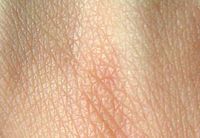
Photo from wikipedia
ETHNOPHARMACOLOGICAL RELEVANCE Hypericum olympicum L. (Hypericaceae) flowering aerial parts has been utilized in Turkish folk medicine as a remedy against (inflamed) skin problems. AIM OF THE STUDY This study was… Click to show full abstract
ETHNOPHARMACOLOGICAL RELEVANCE Hypericum olympicum L. (Hypericaceae) flowering aerial parts has been utilized in Turkish folk medicine as a remedy against (inflamed) skin problems. AIM OF THE STUDY This study was design to state the effect of H. olympicum on dermatological problems. For this purpose effect of the plant extract on the DNA stranded break and matrix metalloproteinase (MMP)-9 activity of human dermal fibroblast (HDFs) cells irradiated with UVB as well as antioxidant activity potential were studied. MATERIALS AND METHOD The methanolic extract of Hypericum olympicum (HOM) was prepared by maceration at room temperature. DNA damage and increased MMP-9 activity in HDFs were induced by UVB irradiation. The cell viability was measured by water-soluble tetrazolium salt (WST)-1 assay. The effects on DNA stranded break was investigated by single gel electrophoresis (commonly known as Comet assay), while MMP-9 activity was observed by gelatin zymography assay. In vitro antioxidant tests were performed to indicate the effect on reactive oxygen species (ROS). The major metabolites were identified and their concentrations were measured by high performance thin layer chromatography (HPTLC). RESULTS HOM was found to recover DNA damage dose-dependently. The enzymatic activity of MMP-9 was inhibited almost 100% by the treatment of 1.5 mg/mL of the extract. It also enhanced cell proliferation in those cells, and also it was shown to possess antioxidant activity. The major metabolites of HOM were identified as chlorogenic acid and quercetin glycosides (rutin, hyperoside, isoquercitrin). CONCLUSION Experimental studies have proven the traditional use of Hypericum olympicum in inflamed skin problems acting by inhibition of the inflammatory pathway and recovery of DNA damage induced experimentally.
Journal Title: Journal of ethnopharmacology
Year Published: 2019
Link to full text (if available)
Share on Social Media: Sign Up to like & get
recommendations!